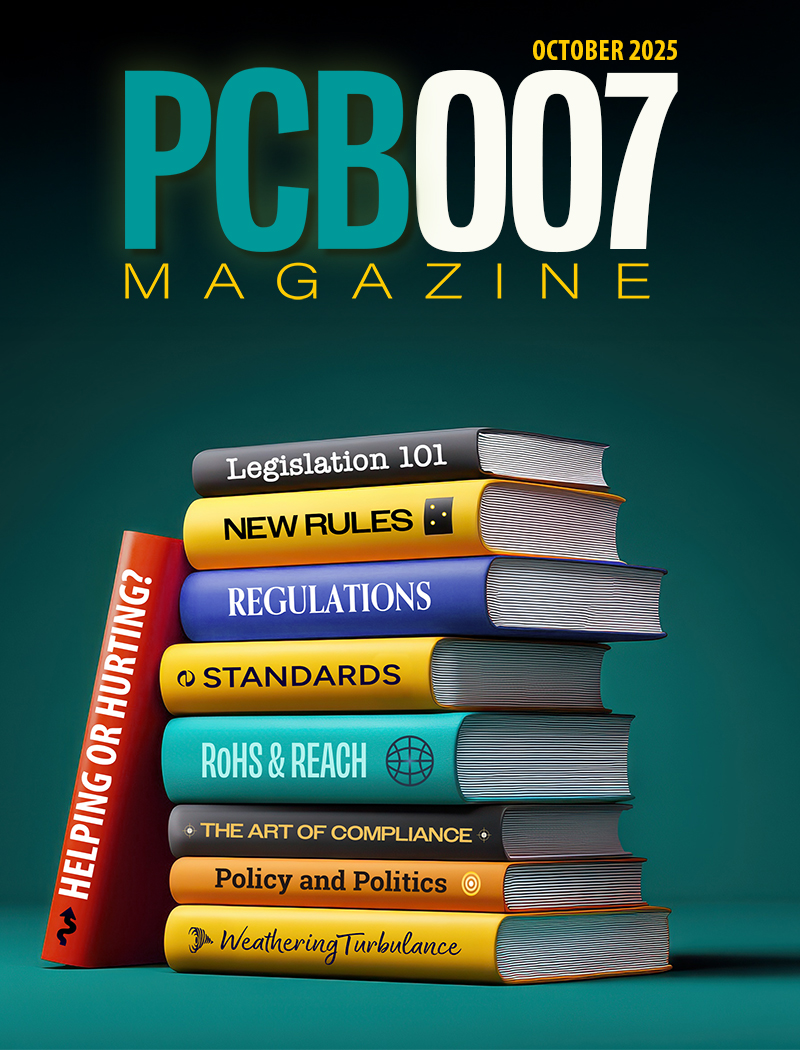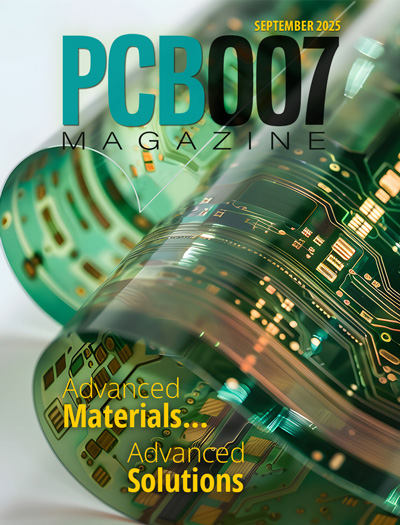-

- News
- Books
Featured Books
- pcb007 Magazine
Latest Issues
Current Issue
The Legislative Outlook: Helping or Hurting?
This month, we examine the rules and laws shaping the current global business landscape and how these factors may open some doors but may also complicate business operations, making profitability more challenging.

Advancing the Advanced Materials Discussion
Moore’s Law is no more, and the advanced material solutions to grapple with this reality are surprising, stunning, and perhaps a bit daunting. Buckle up for a dive into advanced materials and a glimpse into the next chapters of electronics manufacturing.

Inventing the Future With SEL
Two years after launching its state-of-the-art PCB facility, SEL shares lessons in vision, execution, and innovation, plus insights from industry icons and technology leaders shaping the future of PCB fabrication.
- Articles
- Columns
- Links
- Media kit
||| MENU - pcb007 Magazine
Itronics Starts R&D to Recover Tin and Copper from Its “Breakthrough Technology” PCB Refining Pilot Plant
January 16, 2019 | Globe NewswireEstimated reading time: 3 minutes
Itronics Inc., a “Creative Green Technology Company” that produces GOLD’n GRO fertilizers and silver products, has started research and development to recover tin and copper from the silver bullion being produced by its “Breakthrough Technology” Printed Circuit Board Refining Pilot Plant. Tin was on the list of 35 minerals deemed critical to the U.S. National Security and the Economy published by the U.S. Department of Interior on May 18, 2018.
Itronics President, Dr. John Whitney stated, “Our recovery of all of the tin contained on the circuit boards positions the Company to be a world leader in tin recovery from discarded printed circuit boards, a technology advancement of global importance. It also positions Itronics to be the first domestic printed circuit board refiner to recover tin and antimony, making Itronics an emerging domestic “critical minerals” producer.
Itronics had previously announced that its technology recovers all the copper, tin, silver, gold, and palladium (palladium is a Platinum Group Metal, PGM) carried on the discarded circuit boards being refined. The technology also recovers all the antimony, which is a fire-retardant mineral that is used to make the circuit boards fireproof. These metals are contained in the Company’s silver bullion which is sold to a finish refiner for separation and sale.
Itronics has performed laboratory testing which indicates that the copper and tin may be separated from the other metals contained in the bullion. The Company will pursue development of this new metal separation technology. The long-term plan is to become a producer of high purity metals, including the strategic metals tin and antimony, using the Company’s hydrometallurgy and pyrometallurgy technologies. Itronics would benefit if the U.S. decides to provide incentives to increase domestic production of “critical minerals,” including tin, antimony, and palladium.
According to the U.S. Department of Interior, there is no mine production of tin in the United States. All the new tin that is required by the U.S. economy is imported. The most important foreign countries in order of importance that supply tin to the United States are Indonesia, Peru, Malaysia, Bolivia, and Brazil.
The list of critical minerals was published in response to a White House Executive Order issued on December 20, 2017 for the purpose of reducing the United States dependency on imports of critical minerals. Under the Executive Order, a “critical mineral” is defined as “a non-fuel mineral or mineral material that is essential to the economic and national security of the United States, that has a supply chain vulnerable to disruption, and that serves an essential function in the manufacturing of a product, the absence of which would have significant consequences for the economy or national security.”
Itronics is now operating its breakthrough printed circuit board refining technology, which refines circuit boards extracted from e-waste, on a pilot scale at its manufacturing plant in Reno, Nevada. The circuit boards are converted into energy which is used in the refining process, and silver bullion and silver-bearing glass which are sold, thereby eliminating the waste from the environment.
Itronics has pioneered the development of “Zero Waste” material recovery technology that converts liquid photochemical waste into silver bullion and a “non-nutrient metal free” liquid ingredient used to manufacture the line of high quality GOLD’n GRO liquid fertilizers. Dr. Whitney said: “Itronics is now pioneering and has achieved operational proof of concept for its second ‘Zero Waste’ material recovery technology, the breakthrough printed circuit board refining technology which is now being operated at a pilot scale.”
About Itronics
Headquartered in Reno, Nevada, Itronics Inc. is a “Creative Green Technology” Company which produces GOLD’n GRO specialty liquid fertilizers, silver bullion, and silver-bearing glass. The Company’s goal is to achieve profitable green technology driven organic growth in specialty GOLD’n GRO fertilizers, silver, zinc, and minerals. The Company’s technologies maximize the recovery and uses of metals and minerals and by doing this maximize sustainability.
Through its subsidiary, Itronics Metallurgical, Inc., Itronics is the only company with a fully permitted “Beneficial Use Photochemical, Silver, and Water Recycling” plant in the United States that converts 100 percent of the spent photoliquids into GOLD’n GRO liquid fertilizers, silver bullion, and silver bearing glass. This is internationally recognized award winning “Zero Waste” Technology. The Company is developing a portfolio of environmentally beneficial “Zero waste” processing and mining technologies. Itronics has received numerous domestic and international awards that recognize its ability to successfully use chemical science and engineering to create and implement new environmentally green recycling and fertilizer technologies.
Testimonial
"Our marketing partnership with I-Connect007 is already delivering. Just a day after our press release went live, we received a direct inquiry about our updated products!"
Rachael Temple - AlltematedSuggested Items
Episode 6 of Ultra HDI Podcast Series Explores Copper-filled Microvias in Advanced PCB Design and Fabrication
10/15/2025 | I-Connect007I-Connect007 has released Episode 6 of its acclaimed On the Line with... American Standard Circuits: Ultra High Density Interconnect (UHDI) podcast series. In this episode, “Copper Filling of Vias,” host Nolan Johnson once again welcomes John Johnson, Director of Quality and Advanced Technology at American Standard Circuits, for a deep dive into the pros and cons of copper plating microvias—from both the fabricator’s and designer’s perspectives.
Nolan’s Notes: Tariffs, Technologies, and Optimization
10/01/2025 | Nolan Johnson -- Column: Nolan's NotesLast month, SMT007 Magazine spotlighted India, and boy, did we pick a good time to do so. Tariff and trade news involving India was breaking like a storm surge. The U.S. tariffs shifted India from one of the most favorable trade agreements to the least favorable. Electronics continue to be exempt for the time being, but lest you think that we’re free and clear because we manufacture electronics, steel and aluminum are specifically called out at the 50% tariff levels.
MacDermid Alpha & Graphic PLC Lead UK’s First Horizontal Electroless Copper Installation
09/30/2025 | MacDermid Alpha & Graphic PLCMacDermid Alpha Electronics Solutions, a leading supplier of integrated materials and chemistries to the electronics industry, is proud to support Graphic PLC, a Somacis company, with the installation of the first horizontal electroless copper metallization process in the UK.
Electrodeposited Copper Foils Market to Grow by $11.7 Billion Over 2025-2032
09/18/2025 | Globe NewswireThe global electrodeposited copper foils market is poised for dynamic growth, driven by the rising adoption in advanced electronics and renewable energy storage solutions.
MacDermid Alpha Showcases Advanced Interconnect Solutions at PCIM Asia 2025
09/18/2025 | MacDermid Alpha Electronics SolutionsMacDermid Alpha Electronic Solutions, a global leader in materials for power electronics and semiconductor assembly, will showcase its latest interconnect innovations in electronic interconnect materials at PCIM Asia 2025, held from September 24 to 26 at the Shanghai New International Expo Centre, Booth N5-E30


